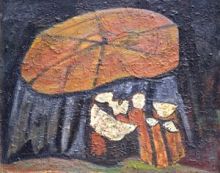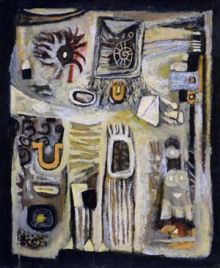He resisted totalitarian regime in Ukraine as a citizen and artist. His creative work, which is an integral part of the all-European process of development of pictorial arts, has not been officially recognized till 1991. Karlo Zvirynsky’s first exhibit took place in Lviv in 1995 when the artist was 73 years old.
Art experts say that the name of Karlo Zvirynsky (1923-97) is indeed connected with the attempts of Ukrainian artists to keep to the actual ideas of art modernism, which was very important during the period of stagnation of the 1940s-1960s. “Under those circumstances he turned out to be the bearer of ideas inherited from many modernist artists, representatives of both Paris schools and academies of arts in Krakow and Warsaw,” Roman Yatsiv, professor of the Lviv Academy of Arts told The Day. “Karlo Yosypovych very well absorbed the formal artistic problematic, felt it intuitively and lived by looking for free contacts.”
In the late 1950s Karlo Zvirynsky, a lecturer at the department of monumental painting of the Lviv Institute of Decorative and Applied Arts (currently Lviv National Academy of Arts) managed to consolidate around himself the youth who sought to overcome the inertness of standardized artistic education imposed by Moscow school, as well as Kharkiv and Kyiv education standards connected social realism, an ugly understanding of realism, which destroyed a whole generation of artists of the 1930s.
“Karlo Zvirynsky took up the mission to give another dimension to the artistic protest in a correct and careful way, showing no apparent resistance. Therefore for youth his unofficial school was very important and he in his apartment received most talented students. Those included Andrii Bokotei, Liubomyr Medvid, Roman Petruk, Zenovii Flinta, Ivan Marchuk, Oleh Minko, Bohdan Soroka. He succeeded in arousing their interest in literature, philosophy, religion, theater, and innovative trends in the world art. Karlo Yosypovych gave the youth an opportunity to take interest in a much wider front of ideas, both cultural and aesthetic. So, in Lviv circumstances he brought the youth to the possibilities of the most active communications with the world.” Later these meetings will be called an underground academy or Zvirynsky’s spiritual school. The artist himself explained why the meetings were necessary: “I saw what the students were taught. They were taught bad things, things they did not need. If they took that path, they would have lost their talent and they would have been lost as citizens. Therefore it seemed to me I had to do everything to help them preserve their natural gift and at the same time develop their human dignity, civic awareness. I wanted them to know who they were and what they had to do and where to go.”
Zvirynsky was a very erudite person. “His works we now ascribe to abstract art have much in common with what many Western artists were working – they have no restrictions, diktat, censure, etc.,” Prof. Yatsiv says. Therefore in the context of Ukrainian art Zvirynsky remains the bearer of freedom and the right to express one’s existential essence: “Among Karlo Yosypovych’s students we have no similar artists, or any resembling Karlo Zvirynsky, instead we have many creative personalities who are very different. He always made emphasis on the universal values of art – not only national peculiarities and traditions. He managed to preserve the equilibrium and dignity of an artist under those totalitarian circumstances, to inspire his contemporaries by higher categories, higher ideas of art.”
Yatsiv recalls: “He took us to the movies to see Parajanov’s Color of Pomegranate [Serhii Parajanov’s poetic cinema parable, which was shot in 1968 at the Virmenfilm film studio and tells about the Armenian poet Sayat-Nova. – Author]. Frankly speaking, I could not explain the meaning of that movie, but he was trying to make us, very young students, understand that there is a high flight in art, such as Parajanov. The same referred to music and literature – he named many parallels between these spheres and art.”
The exhibit is taking place in the halls of the Lviv Art Gallery, at 3, Stefanyka St. Within the framework of the 10th international student open-air painting session in commemoration of Karlo Zvirynsky, and will last till October 5.








